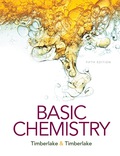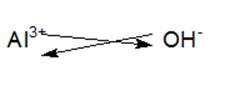
(a)
Interpretation:
The chemical formula of the magnesium sulfate is to be stated.
Concept Introduction:
A chemical formula of a given compound is used to describe the number of atoms present in it. Since a compound is made of two or more than two different elements in definite proportion, a chemical formula can best describe the number of elements it contains with their atomic symbols.
(a)
Answer to Problem 6.57FU
The chemical formula of magnesium sulfate is MgSO4.
Explanation of Solution
Magnesium is a second group element belonging to the alkaline earth metal family. To obtain stable noble gas configurationit loses two electrons and forms Mg2+.
Sulfate ion is a polyatomic ion which is composed of one sulfur and four oxygen atoms.It carries a charge of -2.

Hence, in magnesium sulfate, magnesium transfers two of its electrons to sulfate ion which results in the formation of an ionic compound known as MgSO4.
(b)
Interpretation:
The chemical formula of tin (II) fluoride is to be stated.
Concept Introduction:
A chemical formula of a given compound is used to describe the number of atoms present in it. Since a compound is made of two or more than two different elements in definite proportion, a chemical formula can best describe the number of elements it contains with their atomic symbols.
(b)
Answer to Problem 6.57FU
The chemical formula of tin (II) fluoride is SnF2.
Explanation of Solution
Tin or ‘Sn’ is a fourteen group element belonging to the Carbon family. Hence ‘Sn’looses two of its electrons to form Sn2+. Fluorine is a seventeen group element belonging to the halogens family and is non-metallic in nature therefore it gains one electron to form F-.When the chemical formula of an ionic compound is written, the superscript which denotes the charge on the cation becomes the subscript of the anion and vice-versa.

The chemical formula of the resulting compound is SnF2.
(c)
Interpretation:
The chemical formula of aluminum hydroxide is to be stated.
Concept Introduction:
A chemical formula of a given compound is used to describe the number of atoms present in it. Since a compound is made of two or more than two different elements in definite proportion, a chemical formula can best describe the number of elements it contain with their atomic symbols.
(c)
Answer to Problem 6.57FU
The chemical formula of aluminum hydroxide is Al (OH)3.
Explanation of Solution
Aluminum or ‘Al’is a thirteen group element belonging to the Boron family. After losing three electrons from its valence shell Al forms trivalent Al3+ cation. Hydroxide ion is a diatomic ion which consists of oxygen and hydrogen atom bonded covalently and it carries a negative charge. When Al loses three electrons and results in Al3+,three OH gains one electron each and results in OH- to form an ionic compound named as Al (OH)3 or commonly known as aluminum hydroxide. When the chemical formula of an ionic compound is written, the superscript which denotes the charge on the cation becomes the subscript of the anion and vice-versa.

Thus, chemical formula of the resulting compound is Al (OH)3.
Want to see more full solutions like this?
Chapter 6 Solutions
EBK BASIC CHEMISTRY
- can you please answer both these questions and draw the neccesaryarrow_forwardcan you please give the answer for both these pictures. thankyouarrow_forwardPart 1. Draw monomer units of the following products and draw their reaction mechanism (with arrow pushing) | Bakelite like polymer Using: Resorcinol + NaOH + Formalinarrow_forward
- Question 19 0/2 pts 3 Details You have a mixture of sodium chloride (NaCl) and potassium chloride (KCl) dissolved in water and want to separate out the Cl- ions by precipitating them out using silver ions (Ag+). The chemical equation for the net ionic reaction of NaCl and KCl with silver nitrate, AgNO3, is shown below. Ag+(aq) + Cl(aq) → AgCl(s) The total mass of the NaCl/KCl mixture is 1.299 g. Adding 50.42 mL of 0.381 M solution precipitates out all of the Cl-. What are the masses of NaCl and KCl in the mixture? Atomic masses: g: Mass of NaCl g: Mass of KCL Ag = 107.868 g mol- 1 Cl = 35.453 g mol- 1 K = 39.098 g mol- N = 14.007 g mol−1 Na = 22.99 g mol−1 0 = 15.999 g mol 1 Question Help: ✓ Message instructor Submit Questionarrow_forwardPart 1. Draw monomer units of the following products and draw their reaction mechanism (with arrow pushing) Polyester fiber Using a) pthalic anhydride + anhydrous sodium acetate + ethylene glycol B)pthalic anhydride + anhydrous sodium acetate + glycerolarrow_forwardIdentify the missing starting materials/ reagents/ products in the following reactions. Show the stereochemistry clearly in the structures, if any. If there is a major product, draw the structures of the major product with stereochemistry clearly indicated where applicable. Show only the diastereomers (you do not have to draw the pairs of enantiomers). If you believe that multiple products are formed in approximately equal amounts (hence neither is the major product), draw the structures of the products, and show the detailed mechanism of these reactions to justify the formation of the multiple products. If you believe no product is formed, explain why briefly. (6 mark for each, except f and g, which are 10 mark each)arrow_forward
- 3. What starting material would you use to synthesize 3-hydroxypentanoic acid using a NaBH4 reduction?arrow_forward1. Give stereochemical (Fischer projection) formulas for all (but no extras) the stereoisomers that could theoretically form during the reduction of a. the carbonyl group of 2-methyl-3--pentanone b. both carbonyl groups of 2,4-pentanedione (careful!) 2. Predict the products of the reduction of O=CCH2CH2CH2C=O with a. LiAlH4 b. NaBH4 CH3 OHarrow_forwardWhich of the following compounds can be synthesized using one reaction from any alkene, as a major product? If it can be synthesized, propose a route, and you may use any other starting materials, reagents and solvents as needed. If you do not think that it can be synthesized as a major product from an alkene, explain in detail why.arrow_forward
- Draw the stepwise mechanism (with arrow pushing)arrow_forwarda) Explain why product 1 is the kinetic product and product 2 is the thermodynamic product. b) Draw the reaction coordinate diagram for the reaction pathway generating each product. c) State the Arrhenius Equation and explain the terms with their physical significance. d) State and explain which reaction pathway has a higher rate constant. What happens to the rate constant if the temperature has increased?arrow_forwardI just need help with A,F,G,Harrow_forward
 ChemistryChemistryISBN:9781305957404Author:Steven S. Zumdahl, Susan A. Zumdahl, Donald J. DeCostePublisher:Cengage Learning
ChemistryChemistryISBN:9781305957404Author:Steven S. Zumdahl, Susan A. Zumdahl, Donald J. DeCostePublisher:Cengage Learning ChemistryChemistryISBN:9781259911156Author:Raymond Chang Dr., Jason Overby ProfessorPublisher:McGraw-Hill Education
ChemistryChemistryISBN:9781259911156Author:Raymond Chang Dr., Jason Overby ProfessorPublisher:McGraw-Hill Education Principles of Instrumental AnalysisChemistryISBN:9781305577213Author:Douglas A. Skoog, F. James Holler, Stanley R. CrouchPublisher:Cengage Learning
Principles of Instrumental AnalysisChemistryISBN:9781305577213Author:Douglas A. Skoog, F. James Holler, Stanley R. CrouchPublisher:Cengage Learning Organic ChemistryChemistryISBN:9780078021558Author:Janice Gorzynski Smith Dr.Publisher:McGraw-Hill Education
Organic ChemistryChemistryISBN:9780078021558Author:Janice Gorzynski Smith Dr.Publisher:McGraw-Hill Education Chemistry: Principles and ReactionsChemistryISBN:9781305079373Author:William L. Masterton, Cecile N. HurleyPublisher:Cengage Learning
Chemistry: Principles and ReactionsChemistryISBN:9781305079373Author:William L. Masterton, Cecile N. HurleyPublisher:Cengage Learning Elementary Principles of Chemical Processes, Bind...ChemistryISBN:9781118431221Author:Richard M. Felder, Ronald W. Rousseau, Lisa G. BullardPublisher:WILEY
Elementary Principles of Chemical Processes, Bind...ChemistryISBN:9781118431221Author:Richard M. Felder, Ronald W. Rousseau, Lisa G. BullardPublisher:WILEY





